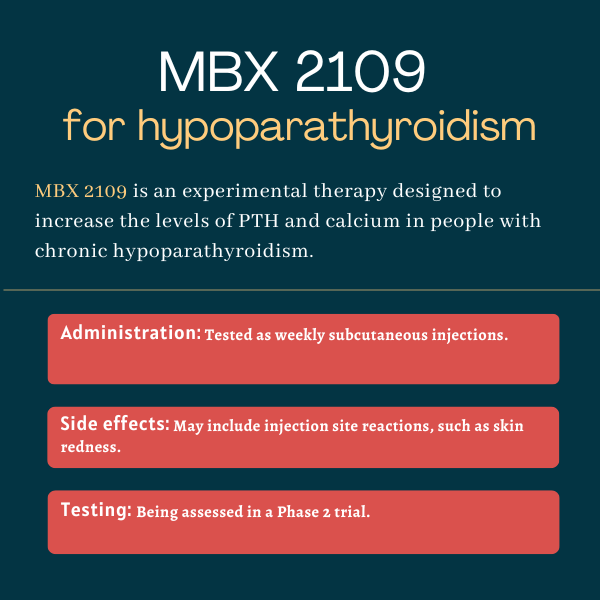MBX 2109 for hypoparathyroidism
Last updated June 27, 2025, by Andrea Lobo, PhD

What is MBX 2109 for hypoparathyroidism?
MBX 2109, also known as canvuparatide, is an injectable hormone replacement therapy being developed by MBX Biosciences to treat chronic hypoparathyroidism.
Hypoparathyroidism is characterized by abnormally low levels of the parathyroid hormone, known as PTH, which helps regulate calcium and phosphorus in the body. Symptoms of hypoparathyroidism are mostly linked to calcium deficiency, and include muscle cramps, unusual sensations like prickling or a feeling of pins and needles, and fatigue.
MBX 2109 contains a prodrug, or an inactive form, of PTH. Once inside the body, it’s converted into a long-acting shortened form of PTH that works in a way similar to the naturally occurring hormone. Fatty acids attached to the prodrug are intended to facilitate extended effects.
The treatment is intended to enable once-weekly dosing, via subcutaneous, or under-the-skin, injection.
Therapy snapshot
| Treatment name: | MBX 2109 |
| Administration: | Subcutaneous injection |
| Clinical testing: | Currently being tested in a Phase 2 trial |
How will MBX 2109 be administered?
In a Phase 2 clinical trial testing MBX 2109 in people with chronic hypoparathyroidism, the therapy is being administered in subcutaneous injections, given once weekly. Three doses — 400, 600, and 800 micrograms — are being tested.

MBX 2109 in clinical trials
MBX 2109 was investigated in a Phase 1 trial (NCT05158335) involving healthy volunteers. Over four weeks, 40 adults received single or repeated ascending treatment doses, of 200, 400, 600, and 900 micrograms, given once weekly. The therapy was tested against a placebo, with the results showing that higher doses led to greater MBX 2109 exposure, and greater increases in calcium. Levels of the therapy were stable with weekly doses.
The Phase 2 Avail trial (NCT06465108) is now testing the therapy’s safety and efficacy in chronic hypoparathyroidism patients. It enrolled 64 adults taking supplements of calcium and active vitamin D, which helps the body absorb calcium. The study is evaluating three doses of MBX 2109 — 400, 600, and 800 micrograms — given once weekly for about three months, against a placebo.
The main goal is to assess the number of participants who can stop vitamin D supplementation and lower their daily calcium dose, while still maintaining blood calcium levels within normal ranges. The treatment’s safety, pharmacological properties, and impact on the patient’s quality of life are also being assessed.
MBX 2109 side effects
Side effects of MBX 2109, seen in healthy volunteers taking part in a Phase 1 trial, were mild and included injection site reactions, particularly erythema, or reddening of the skin. No unexpected or serious side effects were observed.
To date, there is no information on the treatment’s potential side effects in people with hypoparathyroidism.
Hypoparathyroidism News is strictly a news and information website about the disease. It does not provide medical advice, diagnosis, or treatment. This content is not intended to be a substitute for professional medical advice, diagnosis, or treatment. Always seek the advice of your physician or other qualified health provider with any questions you may have regarding a medical condition. Never disregard professional medical advice or delay in seeking it because of something you have read on this website.
Recent Posts
- Hypopara’s unpredictability causes surprises during treatment
- Online tool predicts who’s at risk for chronic complication after surgery
- Reflecting on my experience in a clinical trial during the pandemic
- With hypopara, curiosity about worsening symptoms is crucial
- I feel grateful to be surrounded by love on Thanksgiving
Related content
-
December 5, 2025 by Heather Novak
Hypopara’s unpredictability causes surprises during treatment
-
December 3, 2025 by Bari Vapnek
Reflecting on my experience in a clinical trial during the pandemic
-
November 28, 2025 by Heather Novak
With hypopara, curiosity about worsening symptoms is crucial
-
November 26, 2025 by Bari Vapnek
I feel grateful to be surrounded by love on Thanksgiving
-
November 21, 2025 by Heather Novak
As I turn 41 with hypopara, I’m eager for what the future holds



